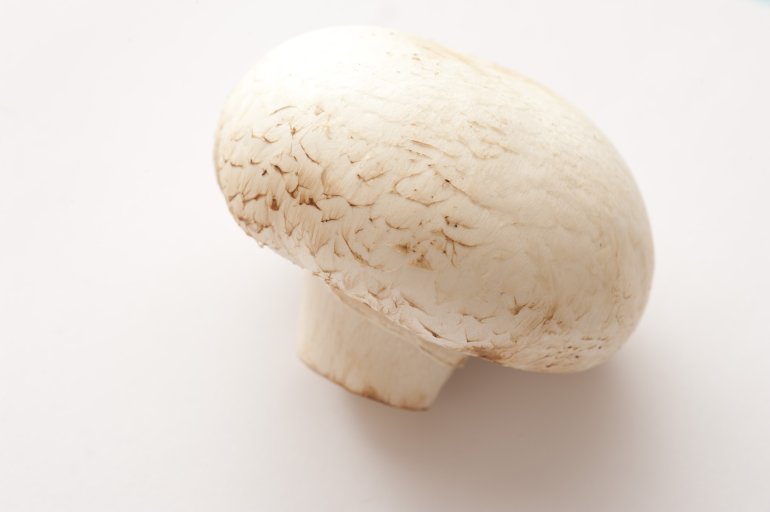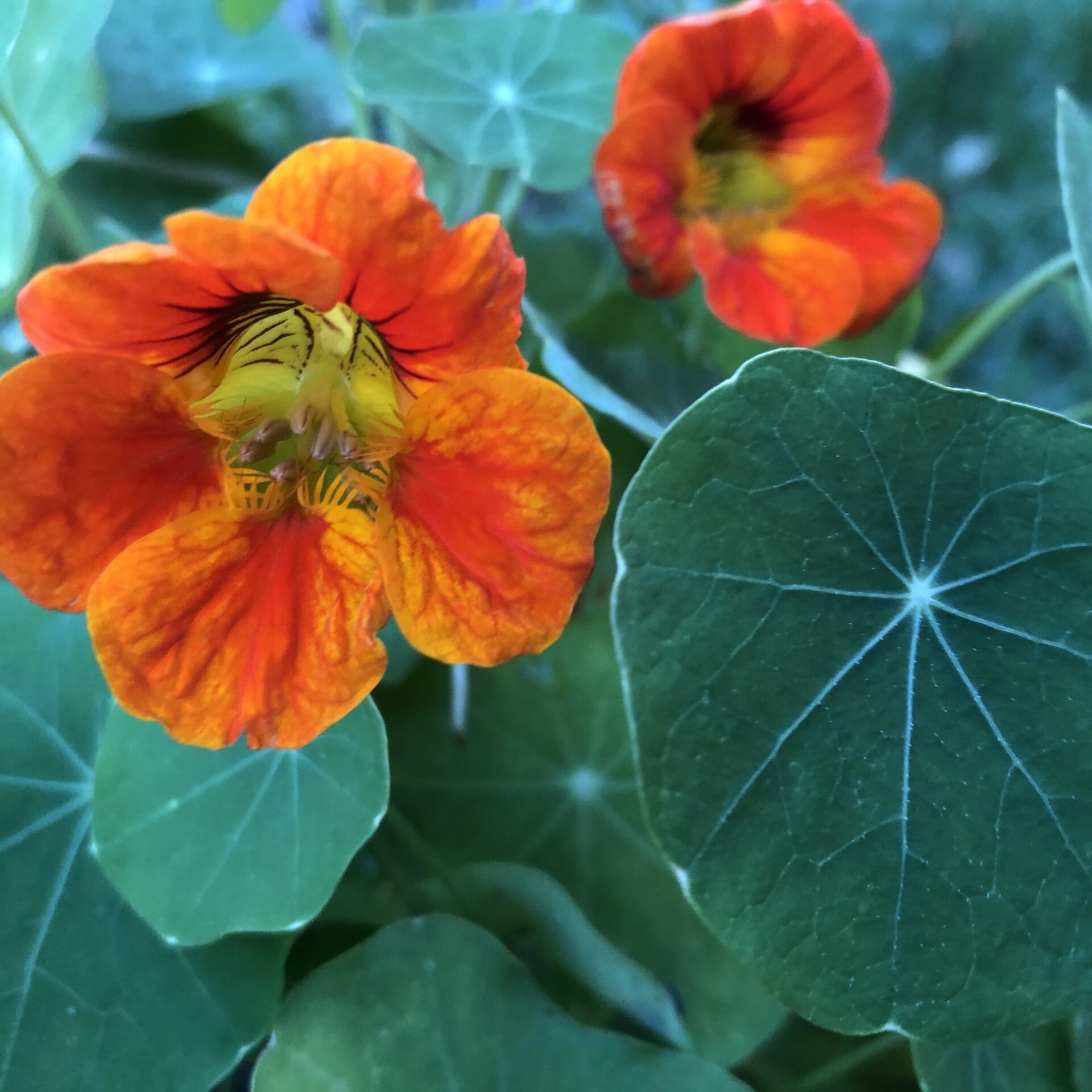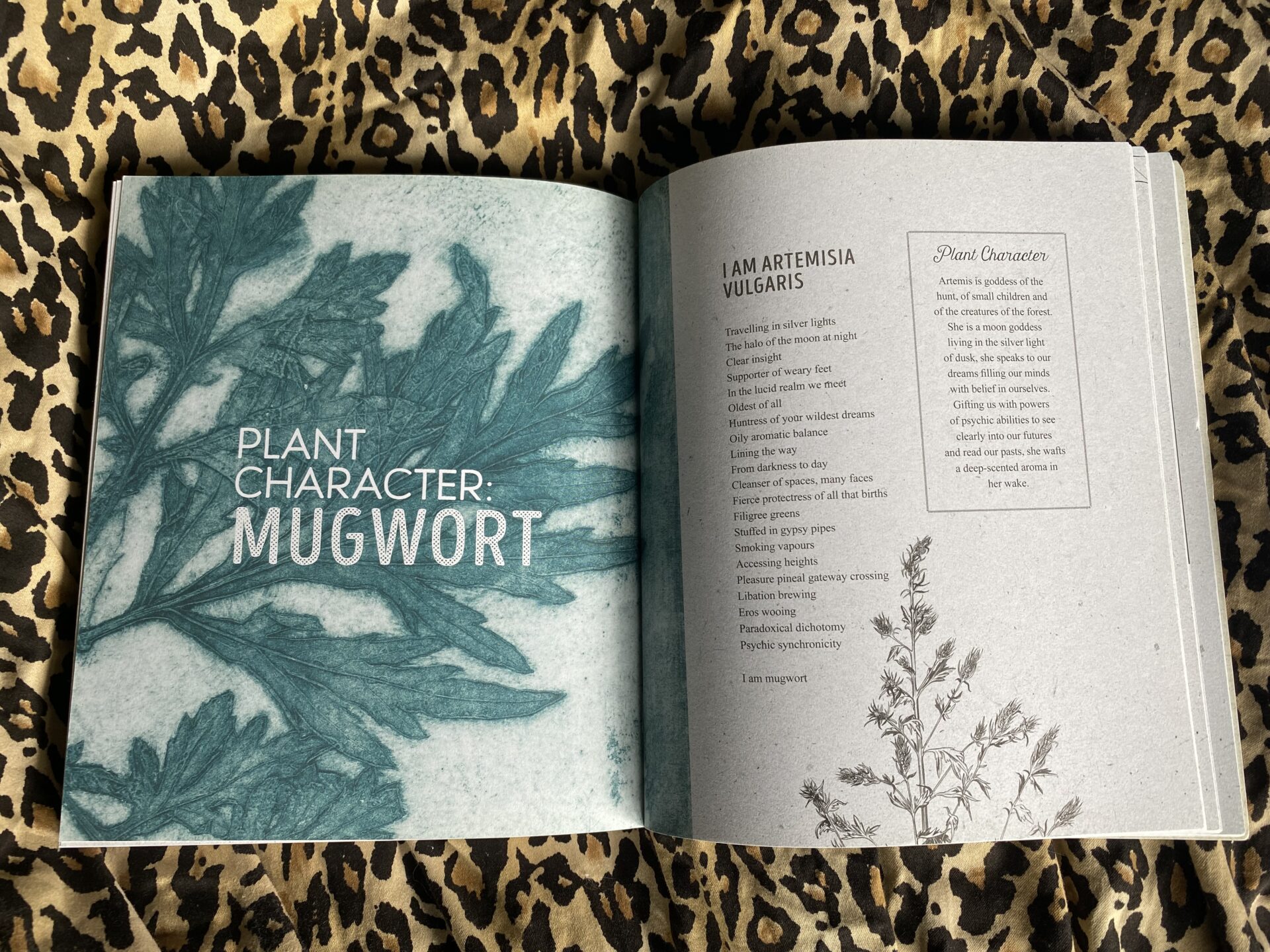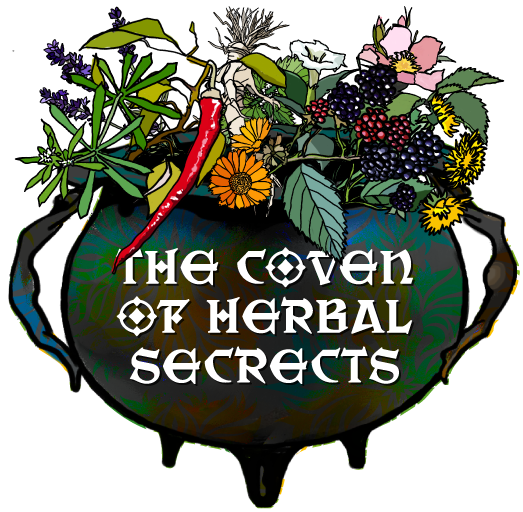Fred Gillam and his partner Natascha run herb and mushroom foraging courses in the UK, as well as a busy voluntary community dispensary using medicinal mushrooms and herbs to promote health and wellbeing. Fred’s business ‘The Wild Side of Life’ has been featured in BBC Countryfile Magazine, ITV’s Countrywise and on BBC Radio2.
Here, he shares the story of his discovery of the relationship between mushrooms and gluten sensitivity.
Picture the scene. A few years ago, after a long successful day with an enthusiastic group on one of our foraging courses, we had two good basketfuls of choice edible mushroom species that they had collectively picked and learned to ID. The autumn light began to fade in the woods and my partner and I prepared a makeshift cooking area on a stack of logs. I lit a small fire and began to sauté the delicious mixture – porcini and other boletes, the green cracked Russula, wood mushrooms, oyster mushrooms, even the (rather delicious if unusual) ‘egg’ stage of the stinkhorn Phallus impudicus. Natascha expertly fried off the shallots, then garlic, rosemary and pepper, and began to sauté the great pile of forest mushrooms that I had been chopping. The heavenly scent of wood smoke and sizzling wild mushrooms wafting through the trees is a rich experience even without the tasting. The lid went on and we hurriedly buttered a great mound of locally baked artisan bread. This of course being the one thing that I was going to miss out on, but by now I was used to it and in any case I had my own gluten free ‘alternative’ so I wasn’t going to go without!
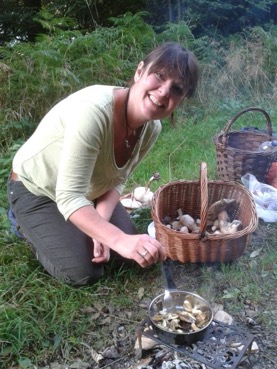
Once the mushrooms had shrunk a little and had sizzled in their own juices it was time to check the seasoning and dish them up onto doorstops of bread. I asked the fledgling foragers to form an orderly queue(!) and one by one I served them, leaving myself until last. I remember audible moans of pleasure as one by one the foraging cohort tucked into their tartine forestiere aux champignons and I too uttered the same as I sank into a well-earned pool of hedonistic drool.
“STOP!” Natascha exclaimed this with some urgency and I was awakened from my dreamy absorption into flavours and simultaneously realised that not only was this good, it was too damn good! I had inadvertently been eating the wrong bread and had consumed a fair amount of wheat by now, at least half of a real doorstop of crusty buttered bread and there would be consequences! The light was fading fast and I decided that we would do well to pack up the kitchen and get ourselves home before the ensuing protests of my body made themselves audibly heard. I could generally expect a pretty severe reaction from this much wheat; a systemic purging involving wheezy breathing, dry cracked skin, a growling belly, stomach cramps, exhaustion, cystitis, and finally diarrhoea. Looking at the possibility of six days off from my then salaried job, my heart began to sink in despair when I suddenly remembered something that I had read during the previous week, which I had spent researching the bioactive compounds in edible mushrooms. Suddenly I realised that there might be some hope!
I had been preparing a paper for delivery at the UK Medicinal Mushrooms Conference and systematically reviewing the groups of known compounds found in medicinal mushrooms. My mind had stuck on enzyme activity and I pondered just what all of these enzymes were there for – what were their primary, overriding purposes? I learned that the group of fungi known as ‘saprobes’, in furnishing their food supply predominantly by composting dead things, were likely to be rich in three groups of enzymes; phytases, proteases and amylases. These can potentially catalyse the breakdown and nutrient-mining of a wide variety of plant material, perhaps including complex structures like gluten. Gluten contains two groups of proteins (gliadins and glutenins) bound up with carbohydrates and cohabiting with phytic acid left over from the cereal grain. Without these saprobic fungi life as we know it would not exist and the surface of the earth as well as the depths of the oceans would be littered miles deep in partially decomposed life forms. Fortunately they have developed a complex biochemical arsenal with which to do their job. [1]
I felt momentary disappointment when I realised that the majority of the mushrooms I had just eaten were not, in fact, saprobes at all but were mycorrhizal species – having co-evolved with plants including trees to dock on to their root systems and exchange nutrients in a symbiotic ‘give and take’ relationship. These, I reasoned, would not do nearly as well and I needed some mushrooms that fed primarily by directly composting plant material if I were to see if they could have any useful effect. Additionally, any mushrooms would have to be consumed raw to avoid denaturing their enzymes and the vast majority of wild mushrooms cannot be safely consumed without prior cooking. On the way home we were going to pass by the local branch of Tesco and they had some fabulous little white round ones that just might do the trick!
The white button mushroom, Agaricus bisporus, is cultivated on compost and is rich in the enzymes necessary to break plant material down into mushroom food. Surely, here I would find a more concentrated source of the phytases, amylases and proteases that might save me from my fate. I had nothing to lose and everything to gain so I obtained two punnets of choice organic white button mushrooms and slowly ate my way through one of them on the journey home! It should be noted, that enzymes are quite specific things. One cannot simply consume any protease and expect it to catalyse the breakdown of any protein; any more than one can consume any amylase and expect it to catalyse the breakdown of any carbohydrate or starch. The human body already produces a limited range of amylases and proteases, was I right to assume that consuming different ones to those found endogenously within my GI tract could do a better job of breaking down the gluten complex, and if so why?
The evening came – and went – unusually with no incident. By the time I went to bed my whole GI tract still felt very settled. I had neither flatus nor eructation and I felt calm as if nothing was about to happen, which was not the norm after consuming wheat and had not been the case for well over a decade, perhaps much longer. I resolved to get some sleep without worrying and to see if I was well enough to go to work in the morning.
Morning came and after a sound night’s sleep I still had not been troubled by any of the signs of my body reacting to the wheaty load. I dressed, ate breakfast and went to work as normal but had the sense to take the other punnet of white button mushrooms with me as an insurance in case any signs of ‘wheat poisoning’ should ensue. Every two hours I consumed two button mushrooms and at the end of the day not only was the punnet empty but I had not experienced even the vaguest discomfort! This was a revelation to me and certainly piqued my curiosity! I also felt a deep sense of empowerment and wonder at my new discovery.
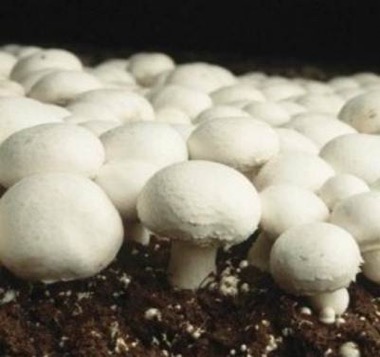
When I got home I went to work once more trying to understand what those enzymes were supposed to do. I knew that it was still an assumption that the proteases, phytases and amylases in white button mushrooms had for me ‘done the trick’ but it was the best I had to go on and I was, remarkably, feeling very well. No signs of having ingested wheat were to manifest over the coming days and I realised that I had stumbled onto something really big. If it were to translate that others with intolerances and allergies to wheat proteins containing gliadins and glutenins were to gain the same benefit, in an age when 1% of the UK population are suffering from coeliac disease and 6% manifesting the symptoms of NCGS (non-coeliac gluten sensitivity), then combining these statistics with the relatively free availability of white button mushrooms to all, this discovery could be REALLY big! [2]
Phytases, Proteases & Amylases — what do these all do?
Phytases catalyse the breakdown of phytic acid (also known as inositol hexakisphosphate), an organic acid that is found in the seed coatings of grains, seeds and nuts, in the cotyledons of beans, and in some other types of plant tissue (e.g. potato tubers). It is abundant in a wide range of raw foraged foods, wholegrain flour and bread, brans and nuts; in fact by definition a wholefood diet tends to be rich in phytic acid.
Phytic acid is used by plants to store phosphorous, and hence the concentration in plant seeds increases just before they ripen and in tubers it increases just before they mature. In seeds, it is thought to act as a reservoir, creating a ready supply of valuable phosphorus for seedling root development before the root systems have developed well enough to obtain it for themselves. It is known to cause digestive problems for some people, acting as an irritant in the lower GI tract as well as binding to (chelating) and preventing the uptake of certain minerals (e.g. zinc, iron, manganese). Some have dubbed phytic acid an ‘anti-nutrient’ however this would seem to be an over-reaction since not only is phytic acid found in an enormously wide variety of plant based foods but it has also been demonstrated to act as an anti-oxidant in the body and to prevent the growth of certain laboratory cancer strains. I think it would be fair to say that phytic acid could act as an irritant in too high a quantity or in the GI tract of individuals with inflammatory disorders. Its ability to chelate (bind) minerals is also reduced when there is adequate dietary vitamin C.
Since mushrooms also require phosphorus they can liberate it from plant based sources by deploying phytases. Some of the wholegrain foods regarded as being beneficial to the balance of GI health (e.g. wild rice and wholegrain brown rice) contain some of the highest concentrations of phytic acid of all, and I had consumed these as well as potatoes (another rich source) with no ill effect for a very long time, so I began to take the view that phytic acid was unlikely to be the major culprit in my own history of gastro-intestinal distress. In my case, the prevalence of phytases in saprobic mushrooms may be a red herring. However, prior to my mushroom experiment and subsequent research, phytic acid had been on my suspect list for some time and it may well be relevant to some individuals. Incidentally, sprouting seeds and grains increases their phytase concentration and reduces the concentration of phytic acid / phytates accordingly. [3, 4]
Proteases catalyse the breakdown of certain groups of proteins, in point of fact pepsin, manufactured in the stomach lining and activated when needed by stomach acid, is a human protease that assists with digestion of certain proteins including those from meat. Tripsin and chymotrypsin, two further proteases, are manufactured in the pancreas and activated in the small intestine. Proteases facilitate the breaking down of a structurally diverse range of proteins into amino acids and peptides, the protein building blocks. They are highly specialised enzymes and they often work in concert with other enzymes. For example pepsin has a much better success with breaking down casein from milk when it is first acted upon by another protease called renin, also manufactured in the stomach lining. Gelatin and collagen from animal origin are similarly pre-digested by a protease known as gelatinase. I reasoned that since white button mushrooms thrive on composted plant material they ought to be a good source of suitable proteases to augment the action of human proteases, helping me to digest protein rich plant material too. Hopefully that just might include plant material containing gluten-like proteins.
Amylases are a group of enzymes that catalyse the breakdown of carbohydrates. Since gluten is in fact a protein complex comprised of gliadin and glutenin sub-units that are bound to carbohydrates, it is reasonable to suspect that amylases will play a very important role in the breakdown of gluten in the digestive tract, and again this could well be the type of mechanism that prevented the development of symptoms when consuming raw mushrooms after eating gluten. Similarly to proteases, amylases are also synthesized by a variety of micro-organisms in the gut, including fungi and bacteria. Specific amylases are selective in terms of their potential to catalyse the breakdown of certain classes of carbohydrates. Saprobic mushrooms including white button mushroom are good sources of amylase species.
Gluten is not a simple molecule – a single substance with a single name. It is comprised of clusters from two groups of proteins, the prolamins and the glutelins, bound together with a variety of carbohydrates, giving it the classic glutinous or gloopy quality that makes it so useful for bread dough and pastries. The clusters are hard for the digestive system to penetrate and dismantle. The prolamins that make up gluten vary in structure based upon their cereal origin. Wheat gluten – the most common trigger for gluten sensitivities, allergies and coeliac disease, contains the prolamin structure known as gliadin, (oats – avenin, rye – secalin, barley – hordein). The glutelins found in gluten (known as glutenins) present an even greater structural variability to the digestive process, yet in order for gluten to be adequately digested these must be separated from the prolamin component, requiring a diversity of enzymes to be present. It seems clear from this model of gluten structure that a variety of enzymes from the protease and amylase groups will be required in order to ‘dismantle’ gluten into its constituent parts, prior to digestion. Further proteases will then be required to catalyse the destruction of the prolamin (wheat – gliadin) component, and if there is any inherent sensitivity or allergy to this, or there is coeliac disease present, then the longer the GI tract is exposed to gliadins, or in some cases glutelins of wheat origin, then the more severe the immunological reaction that cascades forwards is likely to be.
Theoretical assertions based on research and observation
1. Based on the untested assumption of all of the above, fungi – and particularly fungi of the right type, can provide a series of supplemental enzymes that can assist the body in the early break down of gluten, and if they are combined with the gluten in the stomach before the chyme containing gluten is released into the duodenum (so ideally consumed within an hour or so of accidental wheat consumption), then there is a possibility of limiting adverse reactions to a very low level where no unpleasant of harmful symptoms manifest for some people. Some people may obtain symptomatic relief and yet significant levels of damage or inflammation could still occur, even with enhanced breakdown and digestion of gluten taking place, so in no way am I advocating the use of these mushrooms as a prophylactic dietary measure.
Many of the micro-organisms that populate the human enteric biome also have an ability to produce a diverse range of beneficial proteases and amylases, including bacterial and fungal species (even Candida). There is some evidence suggesting that coeliac sufferers produce anti-bodies to organisms that are routinely found in the enteric biome of other individuals and that the spectrum of organisms present has characteristic differences, in particular the low numbers of bacteriodetes species present, and the prevalence of firmicutes. This will therefore affect the range of available digestive enzymes produced by symbiont organisms within the GI tract.
2. Reduced biodiversity in the enteric biome can predispose to gluten intolerance. Interestingly, this has been demonstrated in humanised mice studies, where micro-organism free mice developed signs of gluten sensitivity including antibodies to gliadins and appropriate T-cell responses. According to Dr. Verdu, who conducted the study, “the recognized increase in coeliac disease prevalence in the general population over the last 50 years could be driven, at least in part, by perturbations in intestinal microbial ecology.” She adds that “Specific microbiota-based therapies may aid in the prevention or treatment of coeliac disease in subjects with moderate genetic risk”. [5]
The overwhelming majority of us, in common with Dr. Verdu’s mice, have been subjected to antibiotic therapy at some stage in our lives. Anti-biotics can have a devastating effect on the biodiversity and balance of the gut microbiota and this can take a conscious and planned effort to correct. In nature, opportunistic members of the community that are normally held in check by other species may rise to prominence and come to dominate an ecological niche in their absence. This is just as likely to happen in our own GI tract as in a rainforest. Typical protagonists of auto-infection include the proteobacteria; Helicobacter pylori, Escherichia coli being two examples that inhabit the GI tract of the majority of healthy individuals but that can also cause severe infection when their populations go unchecked by competition. Candida albicans, a fungus that is likely to have a positive role in the digestion of carbohydrates and gluten, is another organism that often rises to an unhealthy level of prominence after anti-biotic therapy and may go on to invade areas of tissue where it behaves as a pathogen.
3. It is possible to supplement with enzymes from an external source to replace enzymatic material that would be made available by a diverse biome with the correct species present for the types of food being consumed. This is not a new idea. People who are lactose intolerant can consume lactase with dairy products, or consume live dairy products containing lactase producing microbiota, and often become more or less symptom free. The enzyme Dipeptidyl peptidase-IV or DPP-IV is a human endogenous enzyme expressed on the surface of many cells that has comparatively recently been shown to assist with the breakdown of gluten-like protein complexes in the GI tract. [6] It is included in a range of supplements targeted towards people with gluten sensitivity, demonstrating the possibility of breaking down gluten into much smaller peptide fragments and thus deconstructing the gliadin / glutenin units before they descend deeper into the GI tract. This could also be the type of mechanism at work with the consumption of white button mushrooms.
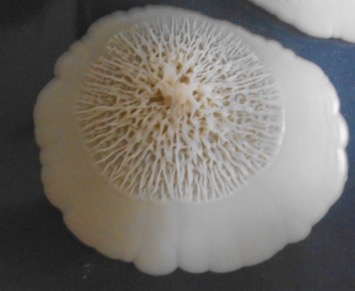
4. My final assertion is that a healthy microbiota is capable of synthesizing suitable enzymes that can assist the body to digest a wide diversity of foods. In this age of antibiotics, preservatives, antiseptics, anti-bacterial cleaning products, bacteriostatic food preparation surfaces, growth-enhancing antibiotic animal feeds and substances like natamycin that are now being added directly to dairy products, unless we become conscious consumers, our gut micro-biome – the rainforest within, does not stand a chance.
However, this is unlikely to be a complete picture when it comes to digesting gluten and gluten sensitivity, since the majority of the enteric biome’s population lives lower down in the GI tract, with only a limited number of species able to tolerate the hostile acidic environment found in the upper GI tract. The presence or absence of certain organisms within the GI tract as a whole appears to play a role in constellating the presentation of immune reactions and also has a direct regulatory function in connection with the gut-brain-endocrine axis; and this may well be the remaining part of the picture.
Conclusion and a cautionary note
Although I am not in a position to prove that the enzymes in white button mushrooms can prevent a person from developing the symptoms of gluten intolerance, it seems logical that this may be the case. I have passed this information on to many people, herbalists, naturopaths and GPs as well as fellow sufferers, and I have received a reasonable amount of positive spontaneous feedback from the people who have either used this principle in their treatment protocols or who have tried it for their own condition.
Despite having documented anti-cancer activity, white button mushrooms do also contain several recognised carcinogens which are significantly reduced in concentration by cooking, although the most abundant of them by far, known as agaritine, is heat stable at cooking temperatures. Since cooking the mushrooms would denature their enzymes this would in any case be undesirable for our purposes. However, agaritine is very water soluble and also degrades in tap water. It can be almost totally removed by slicing the mushrooms thinly and soaking them in a bowl of water for 48 hours. An estimate of the total carcinogenicity of white button mushroom concluded that a human would have to eat on average 350 grams per day of raw mushrooms for 50 years for it to have a carcinogenic effect. [7, 8]
Many people consume raw white button mushroom slices occasionally as a component of salads and it is likely that with occasional use the benefits would far outweigh any harm. However, due to the above I am reluctant to recommend white button mushroom as a prophylactic treatment for gluten sensitivity and only consider it to be truly safe as a first-aid measure when gluten has been accidentally consumed. Additionally, in full-blown coeliac disease serious damage to the lining of the GI tract can occur asymptomatically and prophylactic treatment could induce a false perception of safety. I think the consumption of white button mushrooms after accidental gluten ingestion is a very good idea, but I think it is an unsuitable protocol for prevention and more work would be needed to ensure its safety for this type of use. I suspect that the best results of all would be obtained by working with the gut micro-biota in tandem with the immune system to restore the production of the necessary enzymes endogenously within the body instead.
In my own herbal practice the use of medicinal mushrooms and mushrooms as nutriceuticals has brought positive results for many people over a wide range of conditions.
If you are interested in learning more about the use of medicinal mushrooms, the UK Medicinal Mushrooms Conference in November 2023 will be showcasing relevant information to practitioners including how to manufacture extracts, identification of medicinal mushrooms in the field, mushroom biochemistry, recent scientific discoveries, the synergistic use of medicinal mushrooms and herbs, the use of medicinal mushrooms by indigenous peoples and more!
To find out more visit www.thewildsideoflife.co.uk
References
1 – Dewar D, Amato M, Ellis H, Pollock E, Gonzalez-Cinca N, Wieser H, Ciclitira P, 2006, The toxicity of high molecular weight glutenin subunits of wheat to patients with coeliac disease Eur. J. Gastroenterol. Hepatol. 18 (5): 483–91. PMID 16607142. doi:10.1097/00042737-200605000-00005.
2 – Dr. Christoffer van Tulleken, 2016, What’s the Evidence for the Gluten Free Lifestyle? http://www.bbc.co.uk/news/magazine-37292174, 8th September 2016
3 – Schlemmer U, et al., 2009, Phytate in foods and significance for humans: Food sources, intake, processing, bioavailability, protective role and analysis Mol. Nutr. Food res.2009;53:S330-S375.
4 – Marshall Arebojie Azeke, Samuel Jacob Egielewa, Mary Ugunushe Eigbogbo, Inegbenose Godwin Ihimire, 2011, Effect of germination on the phytase activity, phytate and total phosphorus contents of rice (Oryza sativa), maize (Zea mays), millet (Panicum miliaceum), sorghum (Sorghum bicolor) and wheat (Triticum aestivum) J Food Sci. Technol., 2011 Dec; 48(6): 724-729 Published online 2010 Dec 21. doi: 10.1007/s13197-010-0186-y PMCID: PMC3551043
5 – Elena F. Verdu et al., 2015, Intestinal microbiota modulates gluten-induced immunopathology in humanized mice The American Journal of Pathology, doi: http://dx.doi.org/10.1016/j.ajpath.2015.07.018, published online 8 October 2015
6 – Ehren J, Moron B, Martin E, Bethune MT, Gray GM, Khosla C, 2009 A food-grade enzyme preparation with modest gluten detoxification properties 2009 Jul 21;4(7):e6313. doi: 10.1371/journal.pone.0006313.
7 – H. C. Andersson & Jørn Gry, 2004, Phenylhydrazines in the cultivated mushroom (Agaricus Bisporus): Occurrence, biological properties, risk assessment and recommendations Nordic Council of Ministers, p20, TemaNord 2004: 558
8 – B. Toth & P. Gannett, 1993, Agaricus bisporus: An assessment of its carcinogenic potency Mycopathologia 124: 73-77

